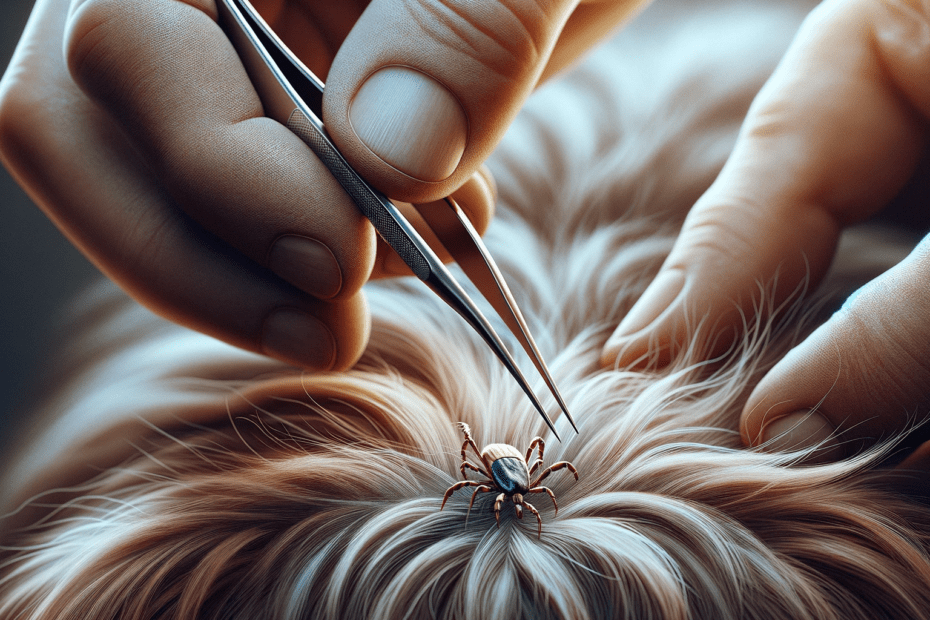Are you itching to learn how to remove a tick from your furry friend?
Well, you’ve come to the right place!
Just like plucking a pesky weed from a garden, removing a tick from a dog requires a careful hand and a few simple steps.
By following these instructions, you can ensure a safe and effective tick removal process for your canine companion.
So, let’s roll up our sleeves (figuratively, of course) and get started on banishing those bothersome ticks from your dog’s skin.
Key Takeaways
- Run fingers slowly over dog’s entire body to scan for ticks.
- Use a tick-removal tool like a tick hook for proper tick identification and removal.
- Wear gloves to protect yourself and pull the tick straight out with a steady motion.
- Dispose of the tick in isopropyl alcohol and clean the affected area with mild antiseptic solution or soap.
Scan for Ticks
You should start by running your fingers slowly over your dog’s entire body to feel for any bumps or swollen areas. Ticks can hide in various places, so it’s important to be thorough in your search. Check between your dog’s toes, legs, ears, face, chin, and neck, as these are common areas where ticks like to latch on. Ticks can be black, brown, or tan in color and have eight legs. Some species of ticks can be as small as a pinhead, so pay close attention to every inch of your dog’s skin.
Regularly checking your pet for ticks is crucial, even if you’re using preventatives. Ticks can still attach themselves to your dog despite preventive measures. If you find a tick, it’s important to remove it promptly to prevent the transmission of diseases. To remove a tick, use fine-tipped tweezers and grasp the tick as close to your dog’s skin as possible. Gently pull upward with steady pressure to ensure you remove the entire tick. Avoid twisting or jerking the tick, as this can make tick removal more difficult and increase the risk of leaving behind parts of the tick.
Proper Tick Identification
Identify ticks accurately by examining their oval shape, large abdomen, small head, and eight legs. Ticks can come in various colors, including black, brown, or tan, and some species can be as small as a pinhead, making proper identification crucial for effective removal. These pests have an oval-shaped body with a prominent abdomen and a small head. They also have eight legs, with four legs on each side of their body. By recognizing these features, you can differentiate ticks from other insects.
Proper tick identification is essential when dealing with tick bites or when removing a tick from your dog. It allows you to take appropriate action and ensure your pet’s well-being. To remove a tick from a dog, you can use a tick-removal tool like a tick hook. This tool helps in safely and effectively removing the tick without squeezing or crushing it. After removing the tick, it’s important to save it in a secure container for identification purposes.
Remember to thoroughly check your dog for ticks, paying close attention to warm and moist areas such as the ears, eyelids, tail, collar area, and between the toes. Prompt removal of a tick is crucial to minimize the risk of tick-borne diseases. By accurately identifying ticks and following the proper tick removal process, you can effectively protect your dog from the harmful effects of tick bites.
Safe Tick Removal
To safely remove a tick from your dog, it’s important to follow the proper tick removal process. Start by wearing gloves to protect yourself from potential diseases that ticks may carry. Using clean tweezers or a tick remover, grasp the tick as close to your dog’s skin as possible. Make sure to avoid squeezing or crushing the tick, as this can increase the risk of disease transmission. Slowly pull the tick straight out, using a steady motion. Be careful not to twist or jerk, as this can cause the tick’s mouthparts to break off and remain embedded in the skin.
After removing the tick, disinfect the area and clean your tweezers with alcohol to prevent any potential contamination. It’s also important to drop the tick into isopropyl alcohol and note the date for safe disposal.
Keep a close eye on the area where the tick was attached for any signs of infection or inflammation, such as redness or swelling. If you notice any concerning symptoms, or if you’re unsure about the proper tick removal technique, it’s always best to consult with a veterinarian. They can provide further guidance and ensure that your dog remains safe and healthy.
Cleanup and After-Care
After removing the tick, it’s important to properly clean the area and provide after-care for your dog.
First, make sure to dispose of the tick carefully. Drop it into a container filled with isopropyl alcohol, and note the date to preserve the tick for potential identification or testing. This not only helps prevent the tick from biting again but also allows for further analysis if necessary.
Next, clean the affected area on your dog’s skin. Use a mild antiseptic solution or soap and warm water to gently clean the wound. This helps prevent infection and soothes any irritation caused by the attached tick. Be sure to wash your hands thoroughly afterwards to avoid any potential transmission of tick-borne diseases.
If you removed the tick using tweezers, clean them with alcohol afterwards. This helps eliminate any remaining tick debris and reduces the risk of spreading tick-borne illnesses. Remember to clean the tweezers properly, focusing on the area where the tick’s head was attached.
Lastly, monitor your dog for any symptoms of tick-borne illness. If the skin remains irritated or infected, it’s important to seek veterinary care for further evaluation and treatment. Prompt attention to your dog’s after-care can help minimize any potential complications from tick bites. Keep an eye out for any changes in behavior, appetite, or overall health, as ticks can transmit various diseases that may increase the risk to your dog’s well-being.
Preventing Future Tick Bites
To prevent future tick bites, you should regularly apply a tick prevention medication to your dog. These medications are designed to repel ticks and prevent them from attaching to your dog’s skin. They come in various forms such as topical solutions, collars, and oral treatments. Make sure to follow the instructions provided by the manufacturer and apply the medication according to the recommended schedule. This will ensure that your dog is protected at all times.
In addition to using tick prevention medication, it’s important to regularly check your dog’s body for ticks, especially after spending time outdoors. Ticks can attach themselves to any part of your dog’s body, so make sure to thoroughly inspect areas such as the ears, neck, armpits, and groin. If you find any ticks, remove them immediately using fine-tipped tweezers or a tick removal tool. Grasp the tick as close to the skin as possible and gently pull upward, making sure to remove the entire tick, including the head.
Ticks can transmit diseases to both dogs and humans, so it’s crucial to take preventative measures to protect your pet. By regularly applying tick prevention medication and checking your dog for ticks, you can significantly reduce the risk of tick bites and the potential transmission of diseases. Remember to consult your veterinarian for the most suitable tick prevention options for your dog.
Frequently Asked Questions
What Will Draw a Tick Out of a Dog?
To draw a tick out of your dog, you can use tick removal tools or fine-tipped tweezers. Gently hook the tick’s body and lift it away from the skin. Clean the area and check regularly for ticks.
What Kills Ticks on Dogs Instantly?
To kill ticks on dogs instantly, drop them into isopropyl alcohol. Use tick removal tools to detach ticks from the skin, killing them in the process. Sanitize the tools and clean the affected area with pet-friendly antiseptic or soap and water.
Does Alcohol Make a Tick Release?
Using alcohol does not make a tick release. It is important to use proper tick removal tools and techniques to safely remove ticks from dogs. Always consult with a veterinarian for natural remedies, tick prevention tips, and tick control products.
Do I Need to Take My Dog to the Vet to Remove a Tick?
If the tick is not easily removed or the bite becomes infected, it is advisable to seek veterinary assistance. A professional can ensure safe and effective removal, as well as provide any necessary treatment or preventive measures.
Conclusion
In conclusion, removing ticks from your dog is a crucial task to ensure their health and well-being. By carefully scanning for ticks, properly identifying them, and safely removing them using clean tweezers or a tick remover, you can effectively protect your dog.
Remember to disinfect the area and clean your tools afterward. By following these steps and taking preventive measures, such as regular checks and grooming, you can keep your furry friend safe from tick-borne illnesses and enjoy many tick-free adventures together.
So, stay vigilant and keep those pesky ticks at bay!






